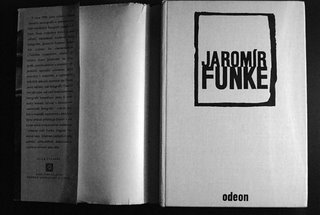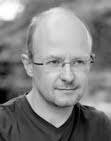Prague visit
 Earlier this week I was in Prague for a brief visit. The city was basking under a balmy spell of Indian Summer. On those days one truly wonders how on earth this planet can be so exquisitely inhabitable.
Earlier this week I was in Prague for a brief visit. The city was basking under a balmy spell of Indian Summer. On those days one truly wonders how on earth this planet can be so exquisitely inhabitable. With ringing names such as Sudek, Saudek and Koudelka associated to it, Prague is a photographer’s city. Last time I went there, I was very lucky to see Sudek’s “Sad Landscape” exhibition. This is amongst the best, most exciting things I have seen in photography, ever. It decisively contributed to my interest in large format.
Sadly, I haven’t seen any photos in Prague this time. However, I bought an impressive, 320 page book recently produced by Chech photographer Jan Reich showing a collection of 150 large format (4x5” and 8x10”) contact prints of Bohemian historical sites (http://www.galerienovysvet.cz/kniboh_titl_en.htm). First I left the shop without buying the book as the pictures themselves are, at first sight, not particularly exciting. Expertly produced, they rarely go beyond a rather factual registration of the castles, monasteries, statues, villas and town squares on display. So it seemed to me the book had simply been conceived as a documentary record of an architectural patrimony. However, after returning to the shop and leafing once more through this hefty tome I came under the spell of this bleak vision: most of the pictures have been taken in the winter with buildings bathing in diffuse light or in a wet mist, and the trees stretching their skeletal contours towards bleached skies. Absolutely nowhere in the book there is any sign of human presence. And, of course, the large format contact prints, with their wealth of detail and their rich tonal palette, are a feast to the eye irrespective of what is actually being shown.
I browsed a couple of bookshops for old books by Koudelka or Sudek but couldn’t find any. I did pick up a handsome volume dedicated to the photography of Jaromir Funke, a contemporary of Sudek. The book is a first edition of a 1970 retrospective of his work.
I shot a few rolls myself on this trip. As I am slowly building up a little portfolio in the square format from these “mixed travels”, I took the Rolleiflex with me. As I largely spent my free hours in the historical district between the Powder Tower and the Castle, I didn’t find it particularly easy to come up with some interesting shots. The city is magnificent, but it has such an overpowering presence that it is difficult to escape the cliché.
Anyway, several people – amongst whom there were Czechs, Chinese and Britons – approached me during my stroll, pointing to the Rolleiflex and exclaiming things like “Aha, a real camera! Good, very good!” and “Wow, how old is it? It must be very expensive.” Whilst focusing the Rollei, I was photographed myself at least twice. Isn’t it amazing? From these reactions we can sense that with the advent of digital technology and polycarbonate bodies something has been lost …
Oh yes, I also picked up a very nice, second hand Yashica Electro 35 GT rangefinder at a bargain price. The camera dates from about the same time as the Funke book – 1970 – and looks great. It’s a black paint version, with a luminous Yashinon 45mm f1.7 lens and a clear viewfinder. To be on the safe side, I shot a roll outside the shop to check rangefinder alignment before buying it. The camera works flawlessly. Let’s see how it performs with a roll of black & white film in it …


0 Comments:
Post a Comment
<< Home